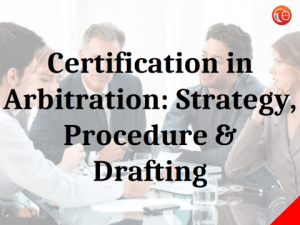This article is written by Debasmita Goswami, pursuing a Certificate Course in Arbitration: Strategy, Procedure and Drafting from LawSikho.
Table of Contents
Introduction
Article II (1) (18) of the New York Convention on the Recognition and Enforcement of Arbitration Awards, 1958 (New York Convention) expressly mentions the binding nature of the arbitration agreement which has been extended to its non – signatories. However, it also mentions that this notion has not been universally accepted and there are certain jurisdictions that do not condone the same. On the contrary, Singapore being a signatory to the 1958 New York Convention has successfully upheld the intent of this Convention in its true meaning and essence. In this regard, it is further imperative to mention that as per the interpretation of Rule 7 of the Singapore International Arbitration Centre (SIAC) it shall be inferred that SIAC has been flexible in allowing the additional parties to be the joinder to the arbitration as claimant or respondent prior to the constitution of the Arbitral Tribunal. Further, it is significant to iterate that the parties have to fulfill one of the requisites which being, either the additional party has to satisfy that it is “prima facie” bound by the arbitration agreement or it needs to showcase that it has duly consented to the joinder. Further, all the other parties have to also give their consent in this regard. The International Commercial Arbitration has evolved over the period time and the extension of the arbitration agreement to the non-signatories places its reliance on various doctrines and judicial pronouncements in order to cater towards the intention of the parties and save their equitable rights. Therefore, through this article, the author has attempted to discuss various doctrines and the precedents pertinent to the jurisdiction of Singapore for a better understanding of the readers.
Settled doctrines and judicial precedents : a way forward
Before delving into the technical aspects first let us understand the true meaning of “Non- Signatories.” In basic terms, a non-signatory may be defined as a party (person or legal entity) who is not a party to the arbitration agreement but wishes to join the proceedings as claimant therefore rightly safeguarding its interest and protecting itself against the malpractices. This can be further established by way of an example:
“Let us consider that a dispute arose between the claimant and the subsidiary of a giant company (parent company) and the dispute resolution clause enshrined in the contract compels arbitration proceedings against the subsidiary company. Now, at this stage in order to get the money back and to claim the necessary relief catering towards its interest the claimant wants to make the parent company a party to the arbitration only in the hope of succeeding in its claim.”
Therefore, through the above example quoted it may be inferred that the sole intention of the claimant in this example is to safeguard its equitable interest and this in no way shall create a hindrance in the way of party autonomy. This can be further substantiated by the jurisprudence laid down by the Singapore Court of appeal in the landmark precedent of International Research Corp PLC v. Lufthansa Systems Asia Pacific Pte Ltd. (Lufthansa Case) wherein the issue raised was whether a third party who entered into supplemental agreements with the original parties should be bound by the dispute resolution clause enshrined in the contract executed between the two parties (original parties in the instant case). The precedent laid down, in this case, has been extremely significant wherein the court has expressly mentioned that “Strict rule in Singapore Jurisprudence shall not be taken as a rule of general application.” Therefore, the Court of Appeal in its judgment has rightly iterated upholding the intention of the parties that the Dispute Resolution Clause enshrined in the Mother Agreement (Cooperation Agreement in the instant case) shall be construed in a way that showcases that the parties had intended to incorporate the arbitration clause/ dispute resolution clause in the supplemental agreements.
This precedent being one of its kind has been of extreme significance in the International Arbitration arena. Subsequently, in another landmark precedent, Tjong Very Sumito, and Others v. Antig Investments Pte. Ltd. (Sumito Case) wherein the arbitration clause/dispute resolution clause was enshrined in the share purchase agreement (mother agreement in the instant case) and the parties further entered into supplemental agreements wherein the Dispute Resolution Clause was not enshrined. Subsequently, a dispute arose between the parties with respect to the payment arrangement in the fourth supplemental agreement and the issue being whether it (payment arrangement) was eligible to be covered under the aegis of the arbitration clause. Going by the factual matrix of the case the court upheld that the parties in the instant case had an intention to be bound by the dispute resolution clause enshrined in the share purchase agreement further extending it to the supplemental agreement. Duly applying the judicial mind the court of appeal in its reasoning has also stated that the independent existence of the supplement agreement without the share purchase agreement would not make any sense which would hardly hold any significance. Therefore, as per the jurisprudence laid down in the instant case, the court in its reasoning was just in upholding the intent of the parties rightly safeguarding their equitable rights and interest.
While the above precedents have been of great value we also cannot overlook the fact that the Courts and Arbitral Tribunals in Singapore have always been confronted with the issue of whether the scope of “Rationae Personae” of an arbitration agreement shall be inclusive of the companies and persons who are not the actual signatories to the arbitration agreement. This issue has always left the Tribunals in dilemma and this is where the two significant doctrines, i.e. doctrines of “Group of Companies” and “piercing the corporate veil” come into play.
The Singapore High Court in the case of Manuchar Steel Hong Kong Ltd v. Star Pacific Line Pte Ltd has rightly iterated that, apart from the jurisdictional aspect the concept of Group of Companies has gained very little traction in the International Arbitration arena however, we can definitely say that it has evolved over the course of the time. In this regard, it is further significant to mention the settled principle of law in Singapore which rightly states that the parties cannot be compelled to arbitrate in pursuance of an arbitration agreement to which they are not the signatories thus, rightly upholding the essence of the “the privity rule” as enshrined under the Contract Act. The High Court of Singapore in the case of Silica Investors Ltd. v. Tomolugen Holdings Ltd. and others has rightly iterated similar principles. The relevant extract of the judgment is as follows:
“Under Singapore law, the referral of matters to an arbitrator is a purely consensual process. There is no power for me to otherwise order that the parts of the dispute not caught by the arbitration clause and those against the other defendants not party to it to also be heard at an arbitration.”
Concluding remarks
In a nutshell, it may be concluded that while extending the arbitration agreement to the non-signatories under Singapore laws one must see the common intention of the parties. Further, it is significant to state that Prof. Bernard Hanotiau in his work titled “Problems Raised by Complex Arbitrations Involving Multiple Contracts-Parties-Issues – An Analysis” has iterated that the concept of “extension” of the arbitration agreement to the non-signatories is a concept that is misleading in its nature as the courts and tribunals usually decide on this issue on the basis of the consent of the parties and the existence of their common intention. Here in the instant case the consent can be both expressed or implied. Further, courts in Singapore through various judicial pronouncements have intended to establish that doctrines such as “piercing the corporate veil” and “group of companies” even though prima-facie appear extremely fancy but may give rise to conflicts when one attempts to do a holistic interpretation of these terms. We cannot say that every jurisdiction has been extremely welcoming of this notion but we can safely say that if executed in the right direction it will be of extreme significance for the parties on the international front. The debates and discussions centred around the proposition i.e. extension of the arbitration agreement to the non-signatories is not something that will be at a standstill very soon. Therefore, to conclude, the author quotes the relevant extract from the landmark decision of the Indian Supreme Court in the case of Chloro Controls Ltd v. Severn Trent Water Purification :
“Where the agreements are consequential and in the nature of a follow-up to the principal or mother agreement, the latter containing the arbitration agreement and such agreements being so intrinsically inter-mingled or interdependent that it is their composite performance which shall discharge the parties of their respective mutual obligations and performances, this would be a sufficient indicator of the intent of the parties to refer signatory as well as non-signatory parties to the arbitration. The principle of ‘composite performance’ would have to be gathered from the conjoint reading of the principal and supplementary agreements on the one hand and the explicit intention of the parties and the attendant circumstances on the other.”
References
- See, https://newyorkconvention1958.org/index.php?lvl=cmspage&pageid=10&menu=618&opac_view=-1 (Last retrieved on 4th August, 2021, 6:45 P.M.) also see, https://www.nortonrosefulbright.com/en-sg/knowledge/publications/eb82eee0/non-signatories-to-arbitration-agreements (Last retrieved on 4th August, 2021, 7:00 P.M.)
- See, https://www.siac.org.sg/our-rules/rules/siac-rules-2016#siac_rule7 (Last retrieved on 4th August, 2021, 8:50 P.M.)
- Nigel Blackaby and Constantine Partasides QC with Alan Redfern and Martin Hunter, Redfern and Hunter on International Arbitration, Oxford Publication, 6th Edition.
- See,https://www.arbitrationicca.org/media/7/07667941615561/non_sign_gr_cies_gr_contr_in_select_asian_coutr_case_law_analysis.pdf (Last Retrieved on 5th August, 2021, 10 P.M.)
- Bernard Hanutiau, Problems Raised by Complex Arbitrations Involving Multiple Contracts-Parties-Issues – An Analysis, Journal of International Arbitration, Vol. 18 Issue3, pp. 253-360.
Students of Lawsikho courses regularly produce writing assignments and work on practical exercises as a part of their coursework and develop themselves in real-life practical skills.
LawSikho has created a telegram group for exchanging legal knowledge, referrals, and various opportunities. You can click on this link and join:












